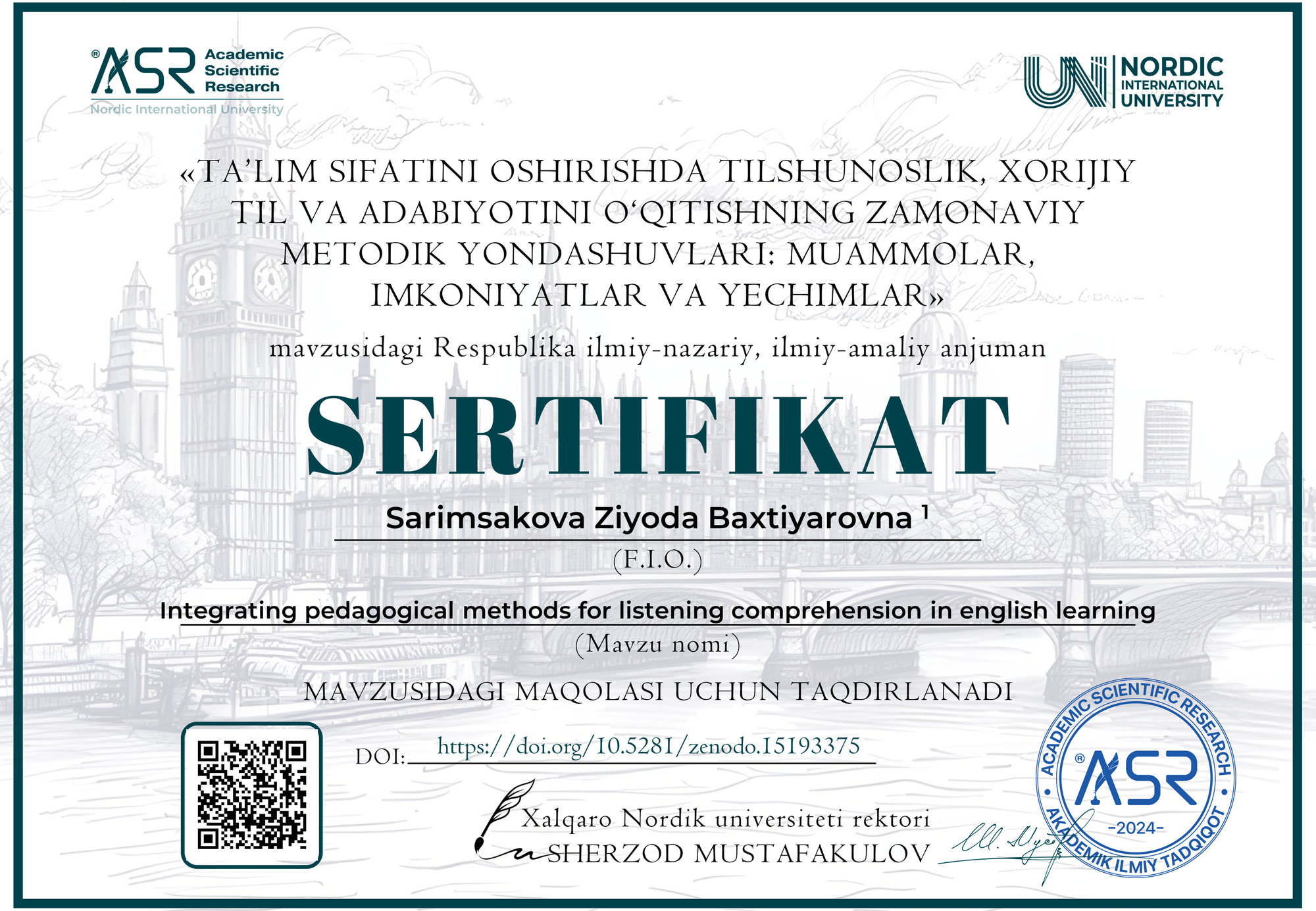Sarimsakova Ziyoda Baxtiyarovna 1

DOI: https://doi.org/10.5281/zenodo.15193375
Zenodo community: https://zenodo.org/records/15193375
Nordic_press journal: https://research.nordicuniversity.org/index.php/nordic/article/view/2313
MAQOLANI YUKLAB OLISH
SERTIFIKATNI YUKLAB OLISH
REVIEW:
The article by Sarimsakova Ziyoda Baxtiyarovna addresses the essential and often challenging skill of listening comprehension in English language teaching (ELT). It offers a thorough exploration of various pedagogical methods designed to improve listening skills, delving into approaches such as bottom-up and top-down processing, interactive learning tasks, and the integration of technology. The article also provides valuable insights into the challenges faced by both learners and educators, while proposing effective solutions for enhancing listening comprehension instruction.
Main Highlights:
The article begins by emphasizing the significance of listening comprehension as a key component of second language acquisition. The author highlights that effective listening skills help learners understand vocabulary, pronunciation, and syntax organically. However, the difficulties of mastering listening comprehension, such as speech rate, unfamiliar accents, and background noise, are well-documented. The paper underscores the need for effective pedagogical strategies to address these challenges and improve learners’ listening skills.
Cognitive Approaches: Bottom-Up and Top-Down Processing:
A central focus of the article is the distinction between bottom-up and top-down cognitive processing in listening comprehension. The bottom-up approach relies on decoding phonemes, syllables, and words to build meaning from linguistic input. On the other hand, top-down processing involves the activation of prior knowledge, context, and expectations to interpret spoken language. The author advocates for a balanced integration of both approaches, which allows learners to construct meaning effectively in real-time. The article presents examples of exercises and strategies that can support these approaches, including phoneme discrimination, summarization, and guided note-taking.
Interactive Learning Tasks:
The article emphasizes the importance of interactive learning tasks to foster engagement and real-world language use. The author proposes activities such as role-playing, group discussions, and information-gap exercises to promote active listening. Additionally, shadowing exercises, where students mimic spoken language, are recommended as they help learners improve pronunciation, rhythm, and intonation. The use of transcripts alongside audio recordings is another useful technique for helping students match spoken language with its written form, thereby strengthening decoding skills.
The Role of Technology in Listening Comprehension:
One of the most significant contributions of the article is its exploration of how technology is transforming listening comprehension instruction. The author discusses how digital tools such as podcasts, audiobooks, and video-based materials provide learners with exposure to diverse accents and speech patterns, which is crucial for adapting to real-world communication. Language learning apps like Duolingo and TED Talks are highlighted as examples of platforms that provide structured listening exercises for various proficiency levels. Furthermore, speech recognition software is discussed as an innovative tool that offers students instant feedback on their pronunciation, helping them improve both listening and speaking skills simultaneously.
Challenges and Solutions in Listening Instruction:
Despite the advances in teaching methods, the article acknowledges that several challenges persist in listening comprehension instruction. Learners often face difficulties with speech rates, unfamiliar vocabulary, and a lack of contextual cues. Moreover, anxiety and cognitive overload can hinder effective listening, especially in test situations. The article suggests that these challenges can be mitigated through adaptive teaching strategies, differentiated instruction, and extensive listening practice. Additionally, the author emphasizes the importance of professional development programs for educators to ensure they are equipped with the necessary tools and techniques for effective listening instruction.
Future Research Directions:
The article concludes by suggesting several areas for future research to enhance listening comprehension instruction. The author proposes that more studies should be conducted to examine the long-term effects of various teaching approaches on listening proficiency across different learner demographics. Furthermore, the role of artificial intelligence (AI) and machine learning in adaptive listening instruction is identified as a promising area of investigation. The integration of virtual reality (VR) and augmented reality (AR) for immersive learning experiences is also suggested as a potential avenue for future exploration. Additionally, the author calls for research on the role of metacognitive strategies in listening comprehension, as these can help learners monitor their understanding and apply corrective measures when faced with challenges.
Conclusion:
In conclusion, the article provides a well-rounded and insightful analysis of the pedagogical methods for improving listening comprehension in English language learners. It successfully outlines the importance of integrating both bottom-up and top-down strategies, while also promoting the use of interactive tasks and technological tools to enhance listening skills. The author’s thorough examination of the challenges faced by learners and educators, along with practical solutions, offers valuable guidance for improving listening comprehension instruction. Furthermore, the suggestions for future research reflect the evolving nature of language learning and the potential for new technologies to further enhance the teaching and learning process.
Overall Assessment:
Sarimsakova Ziyoda Baxtiyarovna's article is a highly informative and well-researched contribution to the field of English language teaching. It provides a comprehensive overview of the current methods and challenges in listening comprehension instruction, making it a valuable resource for educators, curriculum designers, and researchers. The thoughtful integration of traditional pedagogical approaches with modern technological tools makes the article particularly relevant in today’s evolving educational landscape. Overall, the article offers clear and actionable recommendations for improving listening comprehension in ELT settings, contributing to the ongoing development of effective language teaching methodologies.



